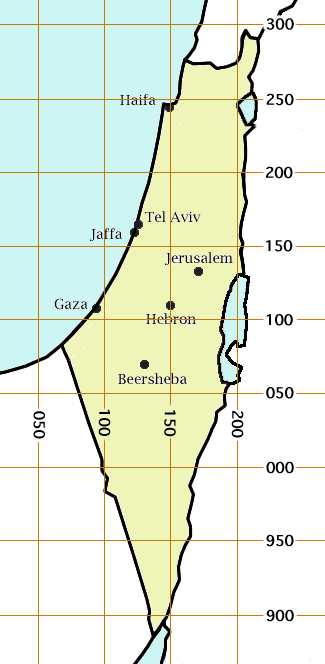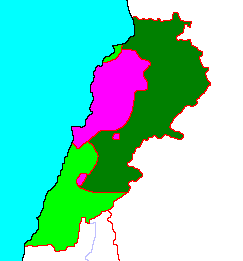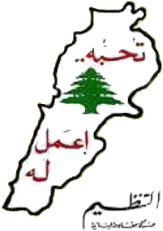|
Kfar Kila, Marjayoun
Kfar Kila or Kfarkila (, also, ''Kfarkila'', ''Kfarkela'', ''Kafarkela'') is a municipality in Southern Lebanon. The majority of its population are Shia Muslims. Etymology Kafarkila name means "the village of the pasturage". History Al-Maqdisi (c. 945/946 – 991) noted that Kafr Kila (called ''Kafar Kila'') was "A place lying a day's march from Tabariyyah". Ottoman era In the 1596 tax records, it was named as a village, ''Kafr Kuk'', in the Ottoman ''nahiya'' (subdistrict) of Tibnin, part of Safad Sanjak, with a population of 31 households and 2 bachelors, all Muslim. The villagers paid taxes on agricultural products, such as wheat, barley, olive trees, goats, beehives and winter pastures; a total of 4,700 akçe.Hütteroth and Abdulfattah, 1977, p. 184 In 1838, Eli Smith noted Kafr Kila's population as Metawileh. In 1875 Victor Guérin visited and noted that the village had about 1,000 Metawileh inhabitants. He further noted: "The mosque and several of the houses are ... [...More Info...] [...Related Items...] OR: [Wikipedia] [Google] [Baidu] |
Palestine Grid
The Palestine grid was the geographic coordinate system used by the Survey Department of Palestine. The system was chosen by the Survey Department of the Government of Palestine in 1922. The projection used was the Cassini-Soldner projection. The central meridian (the line of longitude along which there is no local distortion) was chosen as that passing through a marker on the hill of Mar Elias Monastery south of Jerusalem. The false origin (zero point) of the grid was placed 100 km to the south and west of the Ali el-Muntar hill that overlooks Gaza city. The unit length for the grid was the kilometre; the British units were not even considered. At the time the grid was established, there was no intention of mapping the lower reaches of the Negev Desert, but this did not remain true. Those southern regions having a negative north-south coordinate then became a source of confusion, which was solved by adding 1000 to the northern coordinate in that case. For some military purpo ... [...More Info...] [...Related Items...] OR: [Wikipedia] [Google] [Baidu] |
Safad Sanjak
Safed Sanjak ( ar, سنجق صفد; tr, Safed Sancağı) was a ''sanjak'' (district) of Damascus Eyalet (Ottoman Empire, Ottoman province of Damascus) in 1517–1660, after which it became part of the Sidon Eyalet (Ottoman province of Sidon). The sanjak was centered in Safed and spanned the Galilee, Jabal Amil and the coastal cities of Acre, Israel, Acre and Tyre, Lebanon, Tyre. The city of Safed was made up of Muslim and Jewish townspeople, while the rest of the sanjak was populated by Sunni Muslims, Jewish peasants, Bedouin tribesmen, Shia Muslim, Shia Muslims and Druze peasants. Territory and demographics The territory of Safed Sanjak consisted of the area between the Zahrani River in the north to Mount Carmel (near Haifa) in the south, and the area between the Sea of Galilee in the east and the Mediterranean Sea to the west. Besides Safed, it included the port cities of Acre, Israel, Acre and Tyre, Lebanon, Tyre and the entire Galilee and Jabal Amil area. The district had a mi ... [...More Info...] [...Related Items...] OR: [Wikipedia] [Google] [Baidu] |
Syrian Occupation Of Lebanon
The Syrian occupation of Lebanon ( ar, الاحتلال السوري للبنان, french: Occupation syrienne du Liban) began in 1976, during the Lebanese Civil War, and ended on 30 April 2005 after the Cedar Revolution and several demonstrations in which most of the Lebanese people participated, and the withdrawal agreement was signed by President Bashar al-Assad and Saad Hariri, son of Rafic Hariri. All of these changes were a result from the assassination of former Lebanese Prime Minister Rafic Hariri. In January 1976, a Syrian proposal to restore the limits to the Palestinian guerrilla presence in Lebanon, which had been in place prior to the outbreak of the civil war, was welcomed by Maronites, but rejected by the Palestinian guerrillas. In October 1976, at a meeting of the Arab League, Syria accepted a ceasefire. The League ministers decided to expand an existing small Arab peacekeeping force in Lebanon, but it grew to be a large Arab Deterrent Force consisting almo ... [...More Info...] [...Related Items...] OR: [Wikipedia] [Google] [Baidu] |
Lebanese Civil War
The Lebanese Civil War ( ar, الحرب الأهلية اللبنانية, translit=Al-Ḥarb al-Ahliyyah al-Libnāniyyah) was a multifaceted armed conflict that took place from 1975 to 1990. It resulted in an estimated 120,000 fatalities and an exodus of almost one million people from Lebanon. The diversity of the Lebanese people, Lebanese population played a notable role in the lead-up to and during the conflict: Lebanese Sunni Muslims, Sunni Muslims and Christianity in Lebanon, Christians comprised the majority in the coastal cities; Shia Islam, Shia Muslims were primarily based in Southern Lebanon, the south and the Beqaa Valley in the east; and Lebanese Druze, Druze and Christians populated the country's mountainous areas. The Lebanese government had been run under the significant influence of elites within the Lebanese Maronite Christians, Maronite Christian community. The link between politics and religion had been reinforced under the Mandate for Syria and Lebanon, F ... [...More Info...] [...Related Items...] OR: [Wikipedia] [Google] [Baidu] |
Lebanese Government
Lebanon is a parliamentary democratic republic within the overall framework of confessionalism, a form of consociationalism in which the highest offices are proportionately reserved for representatives from certain religious communities. The constitution of Lebanon grants the people the right to change their government. However, from the mid-1970s until the parliamentary elections in 1992, the Lebanese Civil War (1975–1990) precluded the exercise of political rights. According to the constitution, direct elections must be held for the parliament every four years, however after the parliamentary election in 2009 another election was not held until 2018. The Parliament, in turn, elects a President every 6 years to a single term. The President is not eligible for re-election. The last presidential election was in 2016. The president and parliament choose the Prime Minister. Political parties may be formed; most are based on sectarian interests. 2008 saw a new twist to Lebanes ... [...More Info...] [...Related Items...] OR: [Wikipedia] [Google] [Baidu] |
PEF Survey Of Palestine
The PEF Survey of Palestine was a series of surveys carried out by the Palestine Exploration Fund (PEF) between 1872 and 1877 for the Survey of Western Palestine and in 1880 for the Survey of Eastern Palestine. The survey was carried out after the success of the Ordnance Survey of Jerusalem by the newly-founded PEF, with support from the War Office. Twenty-six sheets were produced for "Western Palestine" and one sheet for "Eastern Palestine". It was the first fully scientific mapping of Palestine. Besides being a geographic survey the group collected thousands of place names with the objective of identifying Biblical, Talmudic, early Christian and Crusading locations. The survey resulted in the publication of a map of Palestine consisting of 26 sheets, at a scale of 1:63,360, the most detailed and accurate map of Palestine published in the 19th century. The PEF survey represented the peak of the cartographic work in Palestine in the nineteenth century. Although the holiness of ... [...More Info...] [...Related Items...] OR: [Wikipedia] [Google] [Baidu] |
Palestine Exploration Fund
The Palestine Exploration Fund is a British society based in London. It was founded in 1865, shortly after the completion of the Ordnance Survey of Jerusalem, and is the oldest known organization in the world created specifically for the study of the Levant region, also known as Palestine. Often simply known as the PEF, its initial objective was to carry out surveys of the topography and ethnography of Ottoman Palestine – producing the PEF Survey of Palestine – with a remit that fell somewhere between an expeditionary survey and military intelligence gathering. It had a complex relationship with Corps of Royal Engineers, and its members sent back reports on the need to salvage and modernise the region.Ilan Pappé (2004) A history of modern Palestine: one land, two peoples Cambridge University Press, pp 34-35 History Following the completion of the Ordnance Survey of Jerusalem, the Biblical archaeologists and clergymen who supported the survey financed the creation o ... [...More Info...] [...Related Items...] OR: [Wikipedia] [Google] [Baidu] |
Victor Guérin
Victor Guérin (15 September 1821 – 21 Septembe 1890) was a French intellectual, explorer and amateur archaeologist. He published books describing the geography, archeology and history of the areas he explored, which included Greece, Asia Minor, North Africa, Lebanon, Syria and Palestine. Biography Guérin, a devout Catholic, graduated from the ''École normale supérieure'' in Paris in 1840. After graduation, he began working as a teacher of rhetoric and member of faculty in various colleges and high schools in France, then in Algeria in 1850, and 1852 he became a member of the French School of Athens. While exploring Samos, he identified the spring that feeds the Tunnel of Eupalinos and the beginnings of the channel. His doctoral thesis of 1856 dealt with the coastal region of Palestine, from Khan Yunis to Mount Carmel. With the financial help of Honoré Théodoric d'Albert de Luynes he was able to explore Greece and its islands, Asia Minor, Egypt, Nubia, Tunisia, and ... [...More Info...] [...Related Items...] OR: [Wikipedia] [Google] [Baidu] |
Metawileh
Lebanese Shia Muslims ( ar, المسلمون الشيعة اللبنانيين), historically known as ''matāwila'' ( ar, متاولة, plural of ''mutawālin'' ebanese pronounced as ''metouali'' refers to Lebanese people who are adherents of the Shia branch of Islam in Lebanon, which plays a major role along Lebanon's main Sunni, Maronite and Druze sects. Shia Islam in Lebanon has a history of more than a millennium. According to the '' CIA World Factbook'', Shia Muslims constituted an estimated 28% of Lebanon's population in 2018. Most of its adherents live in the northern and western area of the Beqaa Valley, Southern Lebanon and Beirut. The great majority of Shia Muslims in Lebanon are Twelvers. However, a small minority of them are Alawites and Ismaili. Under the terms of an unwritten agreement known as the National Pact between the various political and religious leaders of Lebanon, Shias are the only sect eligible for the post of Speaker of Parliament. History ... [...More Info...] [...Related Items...] OR: [Wikipedia] [Google] [Baidu] |
Eli Smith
Eli Smith (born September 13, 1801, in Northford, Connecticut, to Eli and Polly (Whitney) Smith, and died January 11, 1857, in Beirut, Lebanon) was an American Protestant missionary and scholar. He graduated from Yale College in 1821 and from Andover Theological Seminary in 1826. He worked in Malta until 1829, then in company with H. G. O. Dwight traveled through Armenia and Georgia to Persia. They published their observations, ''Missionary Researches in Armenia'', in 1833 in two volumes. Eli Smith settled in Beirut in 1833. Along with Edward Robinson, he made two trips to the Holy Land in 1838 and 1852, acting as an interpreter for Robinson in his quest to identify and record biblical place names in Palestine, which was subsequently published in Robinson's '' Biblical Researches in Palestine''. He is known for bringing the first printing press with Arabic type to Syria Syria ( ar, سُورِيَا or سُورِيَة, translit=Sūriyā), officially the Syrian A ... [...More Info...] [...Related Items...] OR: [Wikipedia] [Google] [Baidu] |
Akçe
The ''akçe'' or ''akça'' (also spelled ''akche'', ''akcheh''; ota, آقچه; ) refers to a silver coin which was the chief monetary unit of the Ottoman Empire. The word itself evolved from the word "silver or silver money", this word is derived from the Turkish ''ak'' ("white") and the diminutive suffix -''ça''. Three ''akçe''s were equal to one ''para''. One-hundred and twenty ''akçe''s equalled one '' kuruş''. Later after 1687 the ''kuruş'' became the main unit of account, replacing the ''akçe''. In 1843, the silver ''kuruş'' was joined by the gold lira in a bimetallic system. Its weight fluctuated, one source estimates it is between 1.15 and 1.18 grams. The name ''akçe'' originally referred to a silver coin but later the meaning changed and it became a synonym for money. The mint in Novo Brdo, a fortified mining town in the Serbian Despotate rich with gold and silver mines, began to strike ''akçe'' in 1441 when it was captured by the Ottoman forces for the fi ... [...More Info...] [...Related Items...] OR: [Wikipedia] [Google] [Baidu] |






